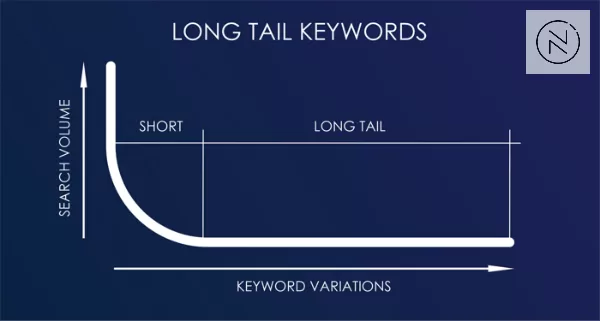Insights
How to Find Long Tail Keywords In 2025: Complete Beginner’s Guide
On Digitals
26/09/2025
26
When it comes to SEO in 2025, ranking for broad, competitive keywords is no longer enough. To reach the right audience and drive meaningful traffic, you need to target long-tail keywords, specific, intent-driven phrases that users actually search for.
This beginner-friendly guide will walk you through everything you need to know to find, evaluate, and use long-tail keywords effectively, even if you’re just starting out.
Overview About Long-tail Keywords
What Are Long-tail Keywords?
Long-tail keywords are search phrases that generally have lower search volume, difficulty, and competition. These keywords are usually longer, consisting of 3 to 5 or more words compared to common short keywords.

Long-tail keywords offer low search volume but high precision
They are used to perform more precise search queries due to their higher specificity and clearer intent. By targeting long-tail keywords, your website faces less competition from major competitors.
Types of Long-tail Keywords
Many people often mistake long-tail keywords as being only phrases with more than three words. In reality, some simply get very specific results, while others are a less common combination of popular terms.
- Topical long-tail keywords: These are extended, longer phrases that are still broad but relate to the overall topic, helping to build comprehensive and encompassing content clusters. For example, “benefits of content marketing for small businesses” is a topical keyword that supports the main topic by exploring related aspects.
- Support keywords: These are very specific phrases that provide additional context for the main keyword by answering detailed questions or covering sub-topics. For example, if your keyword is “digital marketing,” a support keyword for that main key could be “how to create a social media marketing plan.”
Strategically using these two types of keywords helps improve SEO by targeting a wide range of web users’ search intents.
Long Tail Keywords Examples
To clearly see the difference, let’s look at how long-tail keywords appear in real search behavior.
Instead of a broad term like “workout”, someone might search for “home workout plan for busy moms” — a much more specific query. Rather than just typing “Thailand”, a user might search “best time to visit Thailand for solo travelers.”
Similarly, in the tech niche, instead of just “laptop”, users might search for “affordable gaming laptop under $1000 in 2025.” And for someone looking into SEO, a highly targeted query would be “how to find low competition keywords for a blog.”
These examples show how long-tail keywords target specific intent, reflect real-life concerns, and help attract users who are more likely to convert.
Why Focus On Long-tail Keywords In 2025?
Evolving Search Algorithm Trends
In 2025, search engines like Google are increasingly prioritizing user experience and content that precisely matches specific search intent. As Google’s AI and machine learning algorithms have improved, they can now understand context on a much deeper level. Consequently, a long-tail keyword that aligns perfectly with user intent and has lower competition becomes a golden opportunity for your website to achieve higher rankings.
Key Benefits of Investing in Long Tail Keywords

Key benefit of long-tail keywords
There are some reasons that you should be using long-tail keywords
- Lower Competition: Long-tail keywords are typically less competitive, with less search volume, making it easier for your website to reach top positions on search engine results pages (SERPs), perfect for small businesses or new websites.
- Higher Conversion Rates: Users searching with long-tail phrases often have a clearer intent, which significantly increases the likelihood that they will take action (make a purchase, sign up, etc.).
- Specific Content Alignment: Focusing on long-tail keywords helps you create more accurate and detailed content that serves the user’s exact needs.
The Impact of Long-tail on Conversion Rates
Studies show that pages well-optimized with long-tail keywords often achieve conversion rates 2-3 times higher than those that only focus on short-tail keywords. This allows businesses to boost revenue without excessive advertising costs.
This is because long-tail keywords more accurately reflect a user’s specific needs, leading them to a faster purchase or signup decision. As a result, businesses not only attract the right potential customers but also sustainably optimize their marketing expenditure.
How To Find Long Tail Keywords: Step by Step
There are many effective methods and useful tools for finding long-tail keywords. However, you should master a few basic techniques to create more effective, SEO-optimized content.

Use tools to find long-tail keywords step by step
- Use Keyword Research Tools: There are many tools you can check out. If you have the budget, SEMRush is a reliable paid platform that’s well worth the investment.
- Pay attention to Google’s “Searches related to…”: After a search, scroll to the bottom of the Google page to find some terms related to your topic.
- Check the “People Also Ask” sections: This is an easy and free way to find more long-tail keywords. When you search for content or a keyword, keep an eye out for the “People Also Ask” sections as it is a gold mine of specific questions users are searching for within your topic.
- Actively engage in Forums: These are great places to find keyword ideas for your main topic. To easily find what you’re looking for, try searching for “Keyword” + “forum” to get tons of related content with minimal clicking. This is mostly thanks to platforms like Reddit having actual questions from users, so you can have an idea on what your long-tail keywords can be.
- Google Autocomplete: This is another excellent, simple option for finding keywords. Just start typing your topic or keyword, and the system will suggest continuations based on the letters you’ve typed. However, this method can be quite hit or miss, because not every topic has a lot of autocomplete keywords.
After you’ve done your research and found the right long-tail keywords, the next crucial step is to track their performance. This allows you to measure the success of your content and make informed decisions for your SEO strategy. So, let’s explore the essential ways to track long-tail keywords.
Ways to Track Long-Tail Keywords Rank
To know if your long-tail keyword strategy is working, you need to track its performance regularly. Here are the key metrics to monitor:
- Clicks: The number of times users clicked on your link after seeing it in search results. A growing number of clicks for a specific long-tail keyword indicates higher relevance and visibility.
- CTR (Click-Through Rate):
CTR = (Clicks ÷ Impressions) × 100
This tells you how attractive your listing is in the search results. A high CTR means your title and meta description are well-optimized for that long-tail keyword. - Impressions: The number of times your content appeared in search results. Increasing impressions show your content is starting to gain visibility for that keyword, even if it hasn’t ranked high yet.
- Position: The average ranking position of your page for a given keyword. A lower position number (e.g., 1–3) means you’re ranking near the top. Tracking changes over time helps you evaluate SEO progress.
Now that you know how to measure success, let’s move on to how you can strategically integrate long-tail keywords into your SEO plan, not just to rank, but to convert.
How To Integrate Long-tail Keywords Into Your SEO Strategy?
Finding long-tail keywords is just the first step — knowing how to effectively integrate them into your content and SEO workflow is where the real impact happens. Here’s how to do it right:

Long-tail keywords boost SEO and conversions
- Use Them in Strategic Places: Add long-tail keywords naturally into key SEO elements like:
-
- Page title (title tag)
- Meta description
- H1 and subheadings (H2, H3)
- URL (if applicable)
- First 100 words of your content
- Image alt text (if relevant)
- Create Dedicated Content Around Each Long-tail Keyword: If the keyword is highly specific, consider creating a full blog post or landing page to address it in depth. This allows you to target user intent precisely and rank higher for niche queries.
Group Long-tail Keywords into Topic Clusters: Use a pillar page (for a broad keyword) and link it with related long-tail keyword pages to create a content cluster. This helps improve internal linking, site structure, and topical authority in the eyes of Google. - Use Long-tail Keywords in FAQs and Blog Intros: Long-tail phrases are often question-based. Add them to FAQ sections, or use them as subtopics within your article to directly answer specific user queries
- Monitor and Refresh: Track the performance of each page using long-tail keywords, and update content regularly to maintain or improve rankings as search behavior evolves.
Now that you know how to properly integrate long-tail keywords into your SEO strategy, it’s equally important to be aware of the common pitfalls that could undermine your efforts. Even a well-planned strategy can fall short if you’re making basic keyword research mistakes, especially with long-tail keywords, where specificity and user intent are everything.
Let’s look at the most frequent long-tail keyword research mistakes and how to avoid them before they affect your SEO results.
Some Long-tail Keywords Research Mistakes Need to Avoid
While long-tail keywords offer lower competition and higher conversion potential, they still require strategic use. Many beginners make avoidable mistakes during keyword research, which can limit SEO performance or even harm rankings. Let’s walk through the most common issues — and how to avoid them.

Avoid common mistakes when researching long-tail keywords.
- Ignoring Keyword Competition
Just because a keyword is long doesn’t mean it’s easy to rank for. If top-ranking pages are dominated by high-authority domains, it may not be the best starting point.
You can use tools like Ahrefs, Ubersuggest, or Google Keyword Planner to evaluate competition. Start with keywords that have low to moderate difficulty, especially if your site is new.
- Neglecting Informational Keywords
Many focus too much on commercial or transactional keywords, overlooking informational intent — which is crucial for building authority and traffic.
The informational long-tail keywords can be used to create blog posts, tutorials, and guides that educate and build trust with your audience before conversion.
- Keyword Duplication
Beginners often unintentionally target the same or very similar keywords across multiple pages. This creates keyword cannibalization, where your own pages compete with each other.
Plan your content structure carefully and track what keywords are assigned to which pages. SEO plugins like Yoast or RankMath can help avoid duplication.
- Ignoring Local SEO Opportunities
Many fail to target location-specific long-tail keywords, especially if their business serves a local audience. This can be a missed opportunity.
Let’s combine long-tail keywords with location names (cities, districts, neighborhoods) to appear in search results for users searching within your geographic area.

Use location-specific long-tail keywords to boost local SEO
Avoiding these keyword research mistakes can significantly improve your SEO success and save you from costly setbacks. So now that you understand the “do’s and don’ts,” let’s wrap up with a quick look at why long-tail keywords remain such a powerful tool, especially in 2025 and beyond.
FAQ: How to Find Long Tail Keywords In 2025: Complete Beginner’s Guide
1. Are long-tail keywords always more than three words long?
Not necessarily. While many long-tail keywords are typically 3-5 words or more, a more accurate definition is that they are phrases with lower competition and search volume. Some shorter keywords can still be “long-tail” if they are very specific.
2. Why should I prioritize long-tail keywords over short-tail ones?
Long-tail keywords have a higher conversion rate because they reflect a user’s specific search intent. They are also less competitive, making it easier for your website to rank higher and attract the right target audience.
3. Where can I find long-tail keywords for free?
You can use free tools like Google Autocomplete, as well as the “People Also Ask” and “Searches related to” sections on Google’s search results page. Additionally, online forums and communities are excellent sources for new ideas.
4. What’s the next step after I find long-tail keywords?
After finding keywords, you need to strategically integrate them into your content. Use them in your page title, meta description, subheadings (H2, H3), and within the first 100 words of your article to optimize your SEO.
5. Are all long-tail keywords easy to rank for?
No. While they generally have lower competition, you still need to check their competitiveness. If the top-ranking pages are dominated by high-authority domains, you might consider choosing a different keyword or building more in-depth content before trying to compete.
Optimize Long-tail Keywords Effectively with On Digitals
In the evolving SEO landscape of 2025, long-tail keywords are no longer optional, they’re essential. These highly specific search terms allow brands to match content with exact user intent, reduce keyword competition, and boost conversion rates with greater accuracy. When used strategically, long-tail keywords make your content more discoverable, more relevant, and more effective in driving qualified traffic, making them a cornerstone of any modern SEO strategy.
At On Digitals, we believe SEO is not just about ranking, it’s about delivering the right message to the right audience at the right time. Our team of experts specializes in building SEO strategies powered by long-tail keyword research, tailored to your business goals and industry landscape. If you’re ready to take your search visibility and conversions to the next level, On Digitals is here to help.
NEWEST POSTS
- Video Campaign Google Ads: A Practical Guide to Strategy, Formats, and Optimization
- Small Business Branding – 4 Strategies To Boost Your Brand!
- A Complete Guide to Crafting a Powerful Personal Branding Statement That Stands Out
- Brand Identity Explained: Core Definition, Components, and Strategic Value
- Benefits Of Personal Branding – 8 Advantages You Must Know
Read more
